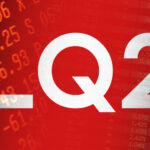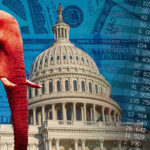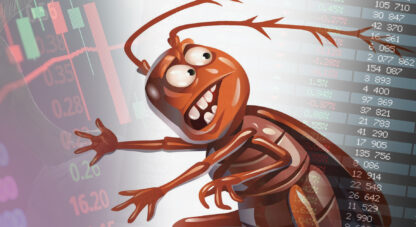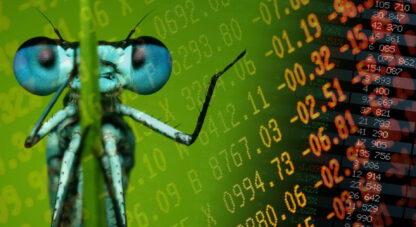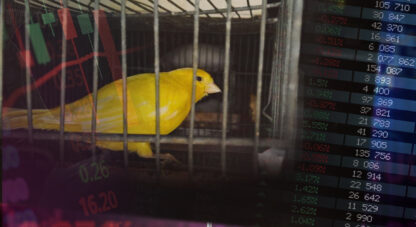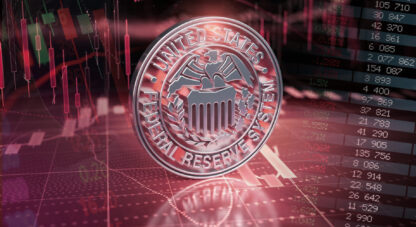December 13 – Financial Times (Chris Giles and Claire Jones): “When the European Central Bank switches off its money-printing press at the turn of this year and stops buying fresh assets, it will mark the end of a decade-long global experiment in how to stave off economic meltdowns. Quantitative easing, the policy that aims to boost spending and inflation by creating electronic money and pumping it into the economy by buying assets such as government bonds, is on the verge of becoming quantitative tightening. With the Federal Reserve slowly reducing its stocks of Treasuries, central banks are no longer in the buying business. Globally, only the Bank of Japan is left as a leading central bank that has not formally called time on expanding its stock of asset purchases. Arguments over how, or even if, the trillions spent by policymakers helped the global economy recover will rage for years to come. But as central banks step back, the initial view is that the purchases worked — whether through encouraging investors to hold more risky assets, easing constraints on borrowing, providing finance so governments could run larger budget deficits or just showing that central banks still had an answer to weak demand and low inflation.”
At this point, the prevailing view holds that QE “worked.” Moreover, central banks are seen ready and willing to call upon “money printing” operations as need. The great virtue of this policy course, many believe, is that there is essentially no limit to the scope and duration of “QE infinity.” The FT quoted Mario Draghi: “[QE] is permanent and may be usable in contingencies that the governing council will assess in its independence.” Melvyn Krauss, from the Hoover Institution, captured conventional thinking: “No one willingly walks into a room from which there is no exit. Because QE proved temporary, because it worked and because it has ended, it is likely to be used again.”
But what if faith in QE is woefully misguided? What if markets and policymakers alike come to appreciate that QE only masked underlying fragilities and delayed desperately needed structural reform? Worse yet, what if the reality is that QE exacerbated latent financial fragility – through more leverage, speculation, misperceptions and market distortions. And what about social and political instability? Surely, there’s growing recognition that a decade of monetary stimulus and resulting Bubbles have further redistributed wealth and worsened inequality.
It was a downbeat Mario Draghi Thursday discussing the end of the ECB’s QE program. Undoubtedly, he always anticipated concluding an unprecedented $2.6 TN ECB balance sheet expansion with the eurozone in an upbeat environment – with Europe’s markets and economies in a good place. They’re anything but.
December’s aggregate eurozone PMI index declined to 51.4, the lowest reading since February 2016. With chaotic riots, France’s industrial sector is now contracting (PMI below 50). Perhaps more troubling, France’s Services PMI sank five points to 49.6, the low going back to February 2016. Germany’s ZEW economic sentiment index collapsed 13 points in December to 45.3. This is down from 95 early in the year and the lowest reading since January 2015.
Yet Europe’s economy is a pillar of strength when compared to the frail political landscape. Surely QE proponents would have expected the printing of $2.6 TN of new “money” to have, at least for a period, worked to pacify the masses and temper political instability. Detractors of unsound money and Credit are anything but surprised by heightened instability throughout the eurozone, certainly including the heavyweight Italian, French and German economies. The euro is arguably more vulnerable today than back in 2012.
Proponents of central bank stimulus operations take a sanguine view. They note that the ECB joined the global QE party late (2014). Truth be told, the ECB and global central banks are a full decade into their exalted monetary experiment. Let’s not forget Draghi’s “whatever it takes,” along with the ECB’s 2012 “Outright Monetary Transactions” program (OMT). Then there was 2011’s “Long-term Refinancing operations (LTRO),” where the ECB lent $640 billion directly to eurozone banks (liquidity in many instances used to buy government bonds). And back in 2010, the ECB adopted their “Securities Market Program.” All told, the ECB’s balance sheet expanded from a pre-crisis $1.5 TN to almost $4.7 TN.
Proponents proclaim a decade of central bank stimulus has proven a tremendous success. They would point first to stock, bond and asset markets more generally. I view the same markets and see acute instability and fragility. I believe a decade of monetary stimulus has exacerbated financial, economic, social, political and geopolitical instabilities. This will surely be debated for decades to come.
Credit is a financial claim – an IOU. New Credit creates purchasing power. Credit is self-reinforcing. When Credit is expanding, the creation of this new purchasing power works to validate the value of Credit generally. In general, new Credit promotes economic activity, both spending and investment, in the process promoting higher incomes. Credit expansions fuel higher price levels throughout the economy, including incomes, real estate, stocks and bonds. Higher perceived wealth stimulates self-reinforcing borrowing, spending and investment.
Traditionally, bank lending for business investment was a prevailing mechanism for finance to enter into the economic system. There were various mechanisms that worked to contain Credit expansions, including the gold standard and disciplined monetary regimes. As important, there were traditions against deficit spending, running persistent trade deficits and profligacy more generally. Moreover, there were bank reserve and capital requirements that placed constraints on lending and financial excess. In short, there was a limited supply of “money,” with excessive borrowing demands pressuring interest rates higher. There was certainly cyclicality, but systems tended toward adjustment and self-correction.
It’s not only the decade-long experiment with QE (with ultralow rates) that makes contemporary finance unique in history. As the key source of additional system “money” and Credit, banks and business investment were some time ago supplanted by market-based finance and leveraged securities/asset purchases. Contemporary (“digitalized”) finance expands virtually without constraint.
Meanwhile, finance entering the system to speculate on higher asset prices creates a very different dynamic than back when bank loans were financing capital investment. Excessive borrowing and investment placed downward pressure on profits, in the process reducing the incentive to borrow, invest and lend. In contrast, a system of unfettered “money” and Credit financing asset prices is acutely unstable. Expanding finance leads to higher asset prices and only greater impetus to borrow and speculate.
Going on a decade now, I’ve been chronicling the “global government finance Bubble.” It has not been ten years of systemic smooth sailing. History’s greatest Bubble stumbled in 2011 on fears of the Fed’s “exit strategy.” The Fed quickly backed off – and then proceeded to double its balance sheet again by 2014. Europe tottered badly in 2011 and 2012, inciting “whatever it takes” and a reckless ECB balance sheet gambit. Fed, ECB and global central bank liquidity stoked a historic boom throughout the emerging markets. China’s epic Bubble, pushed into overdrive with aggressive global crisis-period stimulus, inflated uncontrollably. All of it almost came crashing down in late-‘15/early-’16. But the Chinese adopted more stimulus, the ECB and BOJ boosted QE, and the Fed postponed “normalization.”
I believe the world over the past two years experienced a momentous speculative blow-off – in stocks, bonds, corporate Credit, real estate, M&A, art, collectibles, and so on. I would further argue that speculative melt-ups are quite problematic for contemporary finance. Surging asset prices spur rapid increases in speculative Credit, unleashing new self-reinforcing liquidity/purchasing power upon markets, financial systems and economies around the globe. The problem is it doesn’t work in reverse. The greater the price spikes, the more vulnerable markets become to destabilizing reversals. De-risking/deleveraging dynamics then see a contraction of speculative Credit, leading to problematic self-reinforcing destruction of marketplace liquidity.
As inflationism has demonstrated throughout history, QE was always going to be a most slippery slope. The notion of inflating risk asset markets with central bank liquidity has to be the most dangerous policy prescription in the sordid history of central banking. And, importantly, the longer central bankers held to this policy course the deeper were market structural distortions. Rather than attempting to rectify crucial flaws in contemporary finance, central bankers chose inflationism and market backstops as stabilization expedients. This was a monumental mistake.
The expansion of central bank balance sheets ensured a parallel expansion in global speculative leverage. Over time, there was an increasing multiplier effect on each new dollar/yen/euro/etc. of central bank “money.” The original Fed QE “money” program basically accommodated speculative deleveraging. In contrast, the past few years (in particular) incited an aggressive expansion of speculative leverage throughout global securities and asset markets.
In addition, the parabolic increase in central bank liquidity over recent years was instrumental in the parabolic ballooning of ETF assets and passive investment funds more generally. While not “leverage” in the conventional sense, the enormous growth in ETF/passive funds and associated risk misperceptions have amounted to a historic market distortion. Trillions flowed into risky stocks, bonds, corporate Credit, EM assets and derivative structures believing that these fund shares were a liquid store of (nominal) value. The phenomenon of perceived money-like ETF shares was integral to the global risk market speculative blow-off.
The problem with speculative blow-offs is that they inevitably reverse. Upon the reversal, the seriousness of the problem is proportional to the amount of underlying leverage, the degree of market misperceptions and the scope of associated market and economic structural maladjustment. The world now confronts one hell of a problem.
The unfolding de-risking/deleveraging dynamic is extraordinarily problematic from a liquidity standpoint. A powerful “risk off” dynamic – having unfolded following a global speculative blow-off instigated by massive central bank liquidity injections – leaves global “system” liquidity acutely vulnerable. Faltering global liquidity will now expose the misperception of “moneyness” for ETF and passive index products. As such, global markets are now at high risk to global de-risking/deleveraging fomenting a transformative change in risk perceptions. Past risk reassessments (that seem minor compared to what is now unfolding) have led to panic and dislocation.
Flawed central bank policies are directly responsible for both a decade-long global Bubble and the more recent speculative blow-off. Markets, meanwhile, cling to the belief that central bankers remain fully committed to doing “whatever it takes” to hold bear markets, recessions and crises at bay. There’s a disconnect. The harsh reality is that “whatever it takes” has failed. It was built on fallacious notions of inflationism, markets and finance, more generally. Most regrettably, a tremendous amount of market hopes, dreams and capitalization have been built on little more than fallacy.
Total global Credit growth has slowed dramatically. I would argue speculative (securities and derivative-related) Credit, having evolved into a key marginal source of total global Credit, is now in significant self-reinforcing contraction. This portends liquidity issues for markets, faltering asset values and trouble for economies. In the markets, Fear is supplanting greed. Risk aversion and waning liquidity now spawn powerful Contagion across markets.
December 14 – Bloomberg (Lisa Lee): “Funds exiting the U.S. leveraged loan market at a record pace are clobbering sentiment as they go. History suggests that the record $2.5 billion yanked from funds in the past week could mean more short-term loan price pain. Earlier this year, investors flocked to leveraged loan funds in pursuit of floating-rate assets as the Fed sounded hawkish… The loan market has only suffered two bouts of such outflows exceeding $2 billion… Both times, loan prices sank and took months to recover. In August 2011, when the loan market was roughly half its current $1.3 trillion size, loan funds saw $2.1 billion of outflows… In December 2015, they lost $2.04 billion.”
QE previously bailed out the leveraged loan market twice, along the way solidifying the perception of “moneyness” for leveraged loan fund shares. What was not to like about owning assets with above-market yields that would reset higher as the Fed raised rates? And as “money” flooded into leveraged lending, liquidity and recession risks were about the furthest things from investors’/speculators’ minds.
The Bubble has burst – the greater global Bubble, the Bubble in leveraged lending, and Bubbles across asset classes around the globe. In the case of leveraged loans, I don’t expect another bout of QE to resuscitate Bubble Dynamics. Excess within this market, similar to so many, went to parabolic extremes. Risk misperceptions went to extremes; lending terms to extremes; and speculation to extremes. Now the downside.
December 14 – CNBC (Angelica LaVito): “Johnson & Johnson knew for decades that its baby powder contained asbestos, Reuters said in a new report that drove the company’s shares down more than 10% Friday. Reuters based its report on a review of documents and deposition and trial testimony. It said the review showed that from 1971 to the early 2000s, J&J executives, mine managers, doctors and lawyers were aware the company’s raw talc and finished powders sometimes tested positive for small amounts of asbestos. Those involved discussed the problem but they did not disclose it to regulators or the public, Reuters’ examination found. The company released a statement Friday calling the Reuters article ‘one-sided, false and inflammatory.’”
Company denials and positive analyst comments didn’t stop a double-digit Friday drubbing in Johnson & Johnson’s stock. It’s worth noting that the Healthcare SPDR (XLV) sank 3.4% in Friday trading. Prior to Friday’s drop, the XLV had enjoyed a y-t-d return of 12.6%, trading near all-time highs just seven sessions earlier. The index was up over 53% from 2016 lows (J&J up almost 60%).
It was a timely reminder of how deeply Bubble Dynamics have permeated the marketplace. I would argue that some of the greatest excesses have unfolded in perceived low-risk sectors and strategies, certainly including the “defensive” healthcare space. Perceived low risk became a risky Crowded Trade. In the unfolding bear market, there will likely be few places to hide.
What only weeks ago appeared a rather straightforward meeting is now a pivotal juncture for the Federal Open Market Committee. With low unemployment and relatively robust household and business expenditures, the Fed has been widely expected to raise rates next Wednesday. It may now be a close call. But, then again, the Fed may not yet appreciate the seriousness of what is unfolding in the markets. They’re in a real predicament, along with central bankers around the world. They all waited way too long to begin normalizing monetary policy. Today, normalization has barely even commenced, and yet the Bubble they nurtured has already begun to deflate.
December 11 – Reuters (Stella Qiu and Kevin Yao): “China’s banks extended more new loans than expected in November after a sharp drop the previous month… Chinese banks extended 1.25 trillion yuan ($182bn) in net new yuan loans in November, slightly more than analysts had expected and up from the previous month… Total social financing (TSF), a broad measure of liquidity and credit in the economy, jumped to 1.52 trillion yuan in November from 728.8 billion yuan in October, also beating expectations. But growth of outstanding TSF slowed to a new all-time low of 9.9% from 10.2% in October, as regulators continued to crack down on riskier types of financing…”
We’ll continue to closely monitor Chinese Credit data. Credit growth bounced back strongly in November. Total Social Financing (TSF) rose from a weak October’s $84 billion (weakest since October ’15) to $198 billion. This was still 15% below growth from November ’17. This puts y-t-d TSF expansion at $2.129 TN, down 20% from comparable 2017. This slowdown is explained by contractions in key categories of “shadow” lending.
As noted above, Chinese Bank Loans expanded strongly in November. At $182 billion, new loans were 12% above November ’17. Bank Loans have expanded $2.186 TN y-t-d, running 17% above comparable 2017. At $95 billion, Consumer Loans were 6% above November ’17. Indicative of a booming year of mortgage lending, y-t-d growth in Consumer Loans is running 18% above last year. In numbers that illuminate the scope of China’s mortgage finance Bubble, Consumer Loans increased 44% in two years, 78% in three years and 141% in five years.
I don’t want to imply that resurgent Chinese Credit growth and/or even a more dovish Fed wouldn’t matter. I just believe at this point the bursting global Bubble is increasingly beyond resuscitation. A bold statement, I fully appreciate. But Fear is rapidly supplanting greed in “Core” U.S. securities markets. The “Core” has seen de-risking/deleveraging dynamics attain important momentum. Latent “Core” fragilities are being exposed. And the further the global Bubble deflates, the greater the scope of monetary stimulus required to re-energize broad-based securities market inflation. I fully expect more QE. But it will come in a crisis backdrop. I’ll presume the first few Trillion or so will, at best, accommodate deleveraging.
For the Week:
The S&P500 declined 1.3% (down 2.8% y-t-d), and the Dow fell 1.2% (down 2.5%). The Utilities added 0.5% (up 6.1%). The Banks dropped 5.5% (down 17.4%), and the Broker/Dealers declined 2.6% (down 9.4%). The Transports sank 4.4% (down 10.3%). The S&P 400 Midcaps fell 2.7% (down 8.8%), and the small cap Russell 2000 dropped 2.6% (down 8.1%). The Nasdaq100 slipped 0.3% (up 3.1%). The Semiconductors rallied 1.7% (down 6.0%). The Biotechs declined 1.0% (up 4.8%). With bullion down $10, the HUI gold index dipped 0.8% (down 20.6%).
Three-month Treasury bill rates ended the week at 2.36%. Two-year government yields added two bps to 2.73% (up 85bps y-t-d). Five-year T-note yields rose four bps to 2.73% (up 52bps). Ten-year Treasury yields gained four bps to 2.89% (up 49bps). Long bond yields were unchanged at 3.14% (up 40bps). Benchmark Fannie Mae MBS yields rose four bps to 3.75% (up 76bps).
Greek 10-year yields added a basis point to 4.22% (up 15bps y-t-d). Ten-year Portuguese yields dropped 14 bps to 1.66% (down 28bps). Italian 10-year yields sank 19 bps to 2.94% (up 92bps). Spain’s 10-year yields fell four bps to 1.41% (down 16bps). German bund yields were little changed at 0.25% (down 18bps). French yields gained two bps to 0.71% (down 7bps). The French to German 10-year bond spread widened two to 46 bps. U.K. 10-year gilt yields declined two bps to 1.24% (up 5bps). U.K.’s FTSE equities index recovered 1.0% (down 11.0%).
Japan’s Nikkei 225 equities index declined 1.4% (down 6.1% y-t-d). Japanese 10-year “JGB” yields declined two bps to 0.035% (down 1bp). France’s CAC40 gained 0.8% (down 8.6%). The German DAX equities index increased 0.7% (down 15.9%). Spain’s IBEX 35 equities index rose 0.8% (down 11.5%). Italy’s FTSE MIB index rallied 0.9% (down 13.5%). EM equities were mostly lower. Brazil’s Bovespa index slipped 0.8% (up 14.5%), and Mexico’s Bolsa declined 1.3% (down 16.3%). South Korea’s Kospi index dipped 0.3% (down 16.1%). India’s Sensex equities index gained 0.8% (up 5.6%). China’s Shanghai Exchange declined 0.5% (down 21.6%). Turkey’s Borsa Istanbul National 100 index dropped 3.4% (down 21.5%). Russia’s MICEX equities index fell 2.7% (up 12.1%).
Investment-grade bond funds saw outflows of $3.719 billion, and junk bond funds posted outflows of $2.060 billion (from Lipper).
Freddie Mac 30-year fixed mortgage rates dropped 12 bps to a four-month low 4.63% (up 70bps y-o-y). Fifteen-year rates sank 14 bps to 4.07% (up 71bps). Five-year hybrid ARM rates slipped three bps to 4.04% (up 68bps). Bankrate’s survey of jumbo mortgage borrowing costs had 30-yr fixed rates down four bps to 4.56% (up 41bps).
Federal Reserve Credit last week increased $0.8bn to $4.049 TN. Over the past year, Fed Credit contracted $352bn, or 8.0%. Fed Credit inflated $1.238 TN, or 44%, over the past 318 weeks. Elsewhere, Fed holdings for foreign owners of Treasury, Agency Debt dropped $19.4bn last week to $3.385 TN. “Custody holdings” were little changed y-o-y.
M2 (narrow) “money” supply jumped $55.7bn last week to a record $14.395 TN. “Narrow money” gained $584bn, or 4.2%, over the past year. For the week, Currency increased $1.3bn. Total Checkable Deposits surged $131bn, while Savings Deposits dropped $96.3bn. Small Time Deposits gained $6.3bn. Retail Money Funds rose $13.6bn.
Total money market fund assets surged $93.5bn to $3.003 TN. Money Funds gained $162bn y-o-y, or 5.7%.
Total Commercial Paper rose $14.9bn to $1.090 TN. CP rose $40bn y-o-y, or 3.8%.
Currency Watch:
The U.S. dollar index gained 1.0% to 97.443 (up 5.8% y-t-d). For the week on the upside, the Mexican peso increased 0.1%. For the week on the downside, the South African rand declined 1.6%, the Norwegian krone 1.3%, the British pound 1.1%, the New Zealand dollar 1.0%, the South Korean won 1.0%, the euro 0.6%, the Japanese yen 0.6%, the Swiss franc 0.6%, the Australian dollar 0.5%, the Singapore dollar 0.5%, the Canadian dollar 0.5%, the Swedish krona 0.2%, and the Brazilian real 0.1%. The Chinese renminbi declined 0.48% versus the dollar this week (down 5.8% y-t-d).
Commodities Watch:
December 10 – Financial Times (Henry Sanderson): “China’s imports of key commodities from copper to iron ore and soyabeans fell in November, in the latest sign of a slowdown in the world’s second-largest economy… China’s imports of soyabeans fell to their lowest level in two years, down 38% from a year earlier, following China’s impositions of tariffs on US imports in June… The lower copper imports point to a more worrying trend and reflect the slowdown in key consumer sectors in China such as air conditioning, housing and autos, according to analysts at Citi. China’s imports of copper fell by 3% from a year earlier in November, data released on Monday show. Copper prices have fallen 15% this year…”
The Goldman Sachs Commodities Index dropped 2.4% (down 8.2% y-t-d). Spot Gold slipped $9.90 to $1,238 (down 5.0%). Silver declined 0.4% to $14.637 (down 14.6%). Crude dropped another $1.41 to $51.20 (down 15%). Gasoline fell 3.5% (down 20%), and Natural Gas sank 14.7% (up 30%). Copper was little changed (down 16%). Wheat slipped 0.2% (up 24%). Corn declined 0.2% (up 10%).
Market Dislocation Watch:
December 13 – Reuters (Trevor Hunnicutt): “Record cash streamed out of U.S.-based stock funds and billions more fled bonds in a week of apparently escalated caution, Lipper data showed… More than $46 billion thundered out of U.S. stock mutual funds and exchange-traded funds (ETFs), the most ever, while a near-record $13 billion poured from bonds, according to the research service. Relatively low-risk money market funds pulled in $81 billion, also the most recorded…”
December 11 – Wall Street Journal (Gunjan Banerji and Telis Demos): “Wild trading is straining the plumbing that powers global markets. In November, natural-gas futures surged 18% in one day, the biggest jump in more than a decade, only to plunge nearly 17% the following day. That caused some contracts tied to the fuel to breach central clearinghouse margin limits. And that was just one instance in one market of such breaches. At least 49 times this year, major derivatives contracts globally—including on U.S. Treasurys and the S&P 500—have seen price moves that exceeded margin limits, according to… JPMorgan… These breaches essentially mean that the amount of money traders put up to cover potential losses on trades was insufficient, one of several incidents putting a spotlight on how prepared clearinghouses are for the return of volatility.”
Trump Administration Watch:
December 9 – Reuters (Howard Schneider and Ben Blanchard): “Unless U.S.-China trade talks wrap up successfully by March 1, new tariffs will be imposed, U.S. Trade Representative Robert Lighthizer said on Sunday, clarifying there is a ‘hard deadline’ after a week of seeming confusion among President Donald Trump and his advisers. ‘As far as I am concerned it is a hard deadline. When I talk to the president of the United States he is not talking about going beyond March,” Lighthizer said… ‘The way this is set up is that at the end of 90 days, these tariffs will be raised…’”
December 11 – Reuters (Deirdre Bosa, Kate Fazzini and Sara Salinas): “A Vancouver judge set a $10 million CAD bail ($7.5 million) for Huawei Chief Financial Officer Meng Wanzhou Tuesday, capping a week of increasing trade tensions and strong market reactions around the dispute between the Department of Justice and one of China’s largest hardware companies. The United States had asked the Vancouver court to deny bail for Meng, whose father is a billionaire and a founder of Huawei, calling her a flight risk. Canada has been expected to extradite Meng to the United States over charges that the company improperly took payments from Iran in violation of sanctions against the country.”
December 11 – Reuters (Jeff Mason and Steve Holland): “U.S. President Donald Trump said… he would intervene in the Justice Department’s case against a top executive at China’s Huawei Technologies if it would serve national security interests or help close a trade deal with China… When asked if he would intervene with the Justice Department in her case, Trump said…: ‘Whatever’s good for this country, I would do.’ ‘If I think it’s good for what will be certainly the largest trade deal ever made – which is a very important thing – what’s good for national security – I would certainly intervene if I thought it was necessary,’ Trump said.”
December 11 – CBS News (Kathryn Watson): “An Oval Office meeting between President Trump and Democratic leaders Sen. Chuck Schumer and Rep. Nancy Pelosi spiraled out of control over funding for the border wall…, devolving into what Schumer called a Trump ‘temper tantrum.’ With a potential government shutdown looming less than two weeks away, Pelosi, the presumptive soon-to-be speaker of the House, told Mr. Trump, ‘you will not win’ on the border wall. The president demanded border wall funding — and said he’s not afraid the shut down the government over it. In fact, he said, he’s proud to do so, and will take credit for it. ‘I am proud to shut down the government for border security, Chuck,’ the president said. ‘So I will take the mantle. I will be the one to shut it down. I’m not gonna blame you for it. The last time you shut it down it didn’t work. I will take the mantle of shutting down. And I’m gonna shut it down for border security.’”
December 12 – Financial Times (Nic Fildes and Louise Lucas): “A leaked memo, apparently written by a senior National Security Council official, revealed as far back as the start of this year exactly how worried the US is about Huawei. The rise of the Chinese company to become the world’s biggest supplier of telecoms equipment has given China a huge boost over the US in the race to introduce and develop 5G, the next generation of mobile communications, the memo complained. ‘We are losing,’ it said. ‘Whoever leads in technology and market share for 5G deployment will have a tremendous advantage towards [ . . .] commanding the heights of the information domain.’ Eleven months on, those fears have mushroomed into open conflict between Washington and Beijing, with American officials pushing allied countries to ban Huawei from building their 5G networks, citing concerns over security and the company’s unclear links to the Chinese state.”
December 9 – Financial Times (Emily Feng): “The arrest of Meng Wanzhou, the daughter of the founder of Huawei, in Vancouver this month raises the chance that the telecoms equipment maker could become a new victim in the trade war between the US and China. This year, China’s other big telecoms equipment company, ZTE, took a big hit when the US banned American companies from doing business with it, severely restricting its supply chain. Huawei would be less vulnerable if it faced a similar restriction, but its continued reliance on US-made components, especially in semiconductor chips, means such an export ban would be a big setback for Huawei’s ambitions to be a global leader in the next generation of 5G mobile communication.”
December 9 – Wall Street Journal (Dan Strumpf): “American companies have been crucial in helping Huawei Technologies Co. become the world’s dominant telecommunications player. Silicon Valley giants from Intel Corp. to Broadcom Inc. and Qualcomm Inc. are top suppliers of Huawei, which buys their components to make equipment such as base stations and routers and Huawei mobile phones. By one estimate, Huawei will buy up to $10 billion of components from American companies this year—roughly the value of China’s automobile imports from the U.S. Qualcomm and Intel are also working with Huawei on its development of next-generation 5G technologies, a field in which the Chinese company’s aim to be a global leader has alarmed some in Washington.”
December 12 – Reuters (Roberta Rampton and Jeff Mason): “President Donald Trump said… it would be a mistake if the Federal Reserve raises interest rates when it meets next week, as it is expected to do, continuing his criticism of the U.S. central bank. ‘I think that would be foolish, but what can I say?’ Trump told Reuters… Trump said he needed the flexibility of lower interest rates to support the broader U.S. economy as he fights a growing trade battle against China, and potentially other countries. ‘You have to understand, we’re fighting some trade battles and we’re winning. But I need accommodation too,’ he said.”
Federal Reserve Watch:
December 10 – Reuters (Jonathan Spicer): “A sharp tightening of financial conditions convinced Goldman Sachs’ chief economist that the Federal Reserve is now more likely to pause its interest-rate hikes in March, before continuing with three more policy tightenings later in 2019. Goldman had previously predicted four rate hikes, one more than median Fed forecasts from September – but far more than recent market expectations. ‘We think the probability of a move in March has now fallen to slightly below 50%,’ Goldman’s Jan Hatzius wrote… But ‘we see a return to quarterly hikes in June that last through the end of 2019.’”
December 11 – CNBC (Steve Liesman): “Former Federal Reserve Chair Janet Yellen told a New York audience she fears there could be another financial crisis because banking regulators have seen reductions in their authority to address panics and because of the current push to deregulate. ‘I think things have improved, but then I think there are gigantic holes in the system,’ Yellen said… ‘The tools that are available to deal with emerging problems are not great in the United States.’ Yellen cited leverage loans as an area of concern, something also mentioned by the current Fed leadership.”
U.S. Bubble Watch:
December 11 – The Hill (Niv Elis): “The country’s budget deficit in the first two months of fiscal 2019, which began Oct. 1, was 50% higher than in the same period the previous year, according to the Congressional Budget Office (CBO), though the figure was inflated by timing. In October and November, the federal government spent $303 billion more than it took in, compared to $202 billion in the same period of fiscal 2018… Tax revenues were just 3 percentage points higher than the previous year, largely because of the GOP tax law, while spending surged 18%.”
December 12 – Bloomberg (Alexandre Tanzi): “Total public debt outstanding has jumped by $1.36 trillion, or 6.6%, since the start of 2018, and by $1.9 trillion since President Donald Trump took office… If this year’s growth rate is sustained through the end of the year, it would be the biggest jump in percentage terms since the last year of President Barack Obama’s first term, at a time when the economy needed fiscal stimulus in the aftermath of the financial crisis. As of Monday, the nation’s debt stood at a record $21.9 trillion. The borrowing is needed to cover a budget deficit that expanded by an estimated $779 billion in Trump’s first full fiscal year as president, the widest fiscal gap in six years. By the end of Trump’s first term, the debt is expected to rise by $4.4 trillion despite historically low unemployment, and relatively low interest rates and robust growth.”
December 11 – Reuters (Lucia Mutikani): “U.S. producer prices unexpectedly rose in November as increases in the costs for services offset a sharp decline for energy products, but the overall momentum in wholesale inflation appears to be slowing… The Labor Department… producer price index for final demand edged up 0.1% last month after jumping 0.6% in October. In the 12 months through November, the PPI rose 2.5%, slowing from October’s 2.9% surge.”
December 9 – Financial Times (Sam Fleming): “The US is likely to feel the effects of sharply slowing growth elsewhere in the world, the International Monetary Fund’s chief economist has said amid signs of a loss of momentum in a broadening range of economies. …Maurice Obstfeld said that he is not expecting a recession in the US, but he expects growth to progressively slow in 2019 and 2020 as the effect of tax cuts and spending hikes diminishes. ‘For the rest of the world there seems to be some air coming out of the balloon. That will come back and also affect the US,’ he predicted.”
December 10 – Reuters (Caroline Valetkevitch): “The growing ranks of stock market Eeyores now have another reason to stay glum: Next year’s profit picture is darkening fast… Wall Street analysts have slammed the brakes on estimates for profit growth for S&P 500 companies, which had accelerated for much of the year. Two months ago, 2019 profit growth was pegged at 10.2%; it is now seen at 8.2%, and growing ranks of doubters reckon growth could slow to half that rate or less.”
December 11 – Financial Times (John Gapper): “Think of an industry in which three big companies have used technology and economies of scale to become oligopolies and wield power over other enterprises. It hails not from Silicon Valley but the US east coast. The industry in question is passive investment management, in which computers take the role of human stock pickers and money is channelled into index and exchange traded funds. The Big Three of the US industry — BlackRock, Vanguard and State Street — have gained such size and efficiency that they control 80% of the money invested in US index funds. Even Jack Bogle, founder of Vanguard and pioneer of the modern US index fund industry, is alarmed by their success. He has warned that, ‘if historical trends continue, a handful of giant institutional investors will one day hold voting control of virtually every large US corporation’.”
December 10 – CNBC (Diana Olick): “Homeowners in most places are still seeing their nest eggs get a little bigger, but the gains are shrinking quickly. The average homeowner with a mortgage saw a gain of $12,400 in home equity between the third quarter of last year and this year, according to CoreLogic. That includes price appreciation and paying down the mortgage. That is down from $16,000 in annual gains in the second quarter, and the smallest gain in two years. States in the West did see bigger gains: Home equity increased by $36,500 in California and by $32,600 in Nevada. Home equity actually fell in North Dakota, Louisiana and Connecticut.”
December 9 – Wall Street Journal (Ben Eisen): “The pace of real-estate speculation is slowing, a sign of the darkening outlook in the U.S. housing market. Small-time investors who flooded into real estate in the past decade to take advantage of low borrowing costs and rising home values are starting to cut back. The moves indicate that the market’s short-term risk-takers see limited upside—and possible turbulence—ahead. The number of new home loans issued with terms of three years or less, typically used by investors looking to make a quick profit, dropped by 11% in the July-to-September period from a year earlier. It was the smallest amount since the second quarter of 2015, according to Attom Data Solutions…”
December 12 – Reuters (Lucia Mutikani): “U.S. consumer prices were unchanged in November, held back by a sharp decline in the price of gasoline, but underlying inflation pressures remained firm amid rising rents and healthcare costs… November’s flat reading in the Consumer Price Index… followed a 0.3% increase in October. In the 12 months through November, the CPI rose 2.2%, the smallest gain since February, after advancing 2.5% in October. Excluding the volatile food and energy components, the CPI climbed 0.2%… That lifted the year-on-year increase in the so-called core CPI to 2.2% from 2.1% in October.”
December 13 – Reuters (Lucia Mutikani): “U.S. import prices fell by the most in more than three years in November as the cost of petroleum products tumbled and a strong dollar weighed on prices of other goods, pointing to subdued imported inflation in the near term. The Labor Department said… import prices dropped 1.6% last month…”
December 7 – Wall Street Journal (Greg Bensinger and Maureen Farrell): “Uber… filed paperwork confidentially this week for its initial public offering, according to people familiar with the matter, as it races with smaller rival Lyft Inc. to be the first to market. The S-1 filing with the Securities and Exchange Commission puts Uber neck-and-neck with Lyft. Both planned IPOs are shaping up to be among the biggest in a spate of offerings aimed for 2019. Lyft said Thursday it had filed its S-1, and people familiar with the matter have said it is aiming to debut in March or April. Uber’s filing indicates it could go public as soon as the first quarter… That would be sooner than many observers had expected.”
December 13 – Wall Street Journal (Katherine Blunt and Rebecca Smith): “Already paying some of the highest electricity prices in the country, customers of California’s largest utility, PG&E Corp., could soon face massive rate hikes due to the state’s catastrophic wildfires. While the exact scope of PG&E’s fire-related liability remains uncertain, the utility potentially faces tens of billions of dollars in claims. That would amount to an average power-bill increase of as much as 17% if the full total were passed on to ratepayers, according to one analyst’s estimate. That burden is more likely to be spread between shareholders and ratepayers, but could weigh on the economy of a state that already has high living costs.”
December 12 – Reuters (Richard Leong): “U.S. borrowers filed the most loan requests to buy a home and to refinance one in two months as most lending costs declined to their lowest levels since September, the Mortgage Bankers Association said… In the third quarter, monthly mortgage payments for first-time U.S. homebuyers grew by 15% year-over-year, according to a report from Genworth Mortgage Insurance…”
China Watch:
December 11 – Wall Street Journal (Bob Davis and Lingling Wei): “Beijing sought to ease tensions with Washington as its top trade negotiator told U.S. officials that China was planning to reduce auto tariffs and boost purchases of soybeans and other crops, according to people in both capitals… The two sides held a teleconference involving Treasury Secretary Steven Mnuchin, U.S. Trade Representative Robert Lighthizer and Chinese Vice Premier Liu He, the first session since the two sides had reached a 90-day trade truce… The… talks came amid rising U.S. demands on its economic rival, including calls for China to protect U.S. intellectual property, and to end pressure on U.S. firms to hand over valuable technology to their U.S. partners.”
December 12 – Wall Street Journal (Lingling Wei and Bob Davis): “China plans to replace an industrial policy savaged by the Trump administration as protectionist with a new program promising greater access for foreign companies, people briefed on the matter said, in a move to resolve trade tensions with the U.S. China’s top planning agency and senior policy advisers are drafting the replacement for Made in China 2025—President Xi Jinping’s blueprint to make the country a leader in high-tech industries including robotics, information and clean-energy cars. The revised plan would play down China’s bid to dominate manufacturing and be more open to participation by foreign companies…”
December 9 – Financial Times (Tom Hancock, Kathrin Hille and Demetri Sevastopulo): “China has summoned the US ambassador in Beijing to demand the cancellation of an arrest warrant for Meng Wanzhou, chief financial officer of Chinese telecoms company Huawei, in the latest sign that her detention is souring relations between the two powers. Beijing also threatened Canada with ‘serious consequences’ following the arrest of Ms Meng in Vancouver, highlighting how the stand-off is spilling over into other countries’ relations with China.”
December 12 – Bloomberg (Gregor Stuart Hunter): “Default risk for Chinese companies has climbed to the highest in 13 years as Beijing seeks to rein in its post-crisis construction boom, according to Moody’s Analytics. The research group’s measure of expected default frequency has risen above early-warning levels for about 25% of corporate borrowers. Moody’s Analytics… uses the gauge to isolate companies and sectors that merit further investigation for financial distress. ‘This share has been rising steadily for the past two years and now sits near the highs last seen in 2005,’ Glenn Levine, a senior research analyst, wrote… China has already seen a record pace of bond defaults this year, a consequence in part of policy makers’ efforts to reduce leverage in the financial system.”
December 13 – Bloomberg: “The Chinese government’s ‘Made in China 2025’ plan was introduced as a blueprint for transforming the country into an advanced manufacturing economy. It’s come to represent what international competitors, notably the U.S. under President Donald Trump, dislike about how China plays in the global marketplace. Tariffs imposed by Trump took aim at many of the industries highlighted in the plan… The plan, released in 2015, identified 10 industries in which China aspired to become globally competitive by 2025 and globally dominant during this century. Those industries: robotics, new-energy vehicles, biotechnology, aerospace, high-end shipping, advanced rail equipment, electric power equipment, agricultural machinery, new materials (such as those used in screens and solar cells) and new generation information technology and software…”
December 8 – Reuters: “China’s trade surplus with the United States widened to $35.55 billion in November, compared with $31.78 billion in October… For January-November, China’s trade surplus with the United States was $293.52 billion, compared with about $251.26 billion in the same period last year.”
December 8 – Reuters (Lusha Zhang, Stella Qiu and Ryan Woo): “China reported far weaker than expected November exports and imports, showing slower global and domestic demand… November exports only rose 5.4% from a year earlier…, the weakest performance since a 3% contraction in March, and well short of the 10% forecast…”
December 10 – Bloomberg: “Economic data for China released over the weekend signal a further weakening of both domestic and international demand in November. Factory inflation and the consumer price index slowed, while import growth slumped… The producer price index climbed 2.7% in November from a year earlier, the slowest pace in more than two years. The consumer price index rose 2.2%, slower than estimated… Exports in dollar terms rose 5.4% in November, the customs administration said Saturday, missing estimates. Imports grew 3%, widening China’s trade surplus to $44.7 billion from $34.8 billion. That was the highest this year.”
December 14 – Bloomberg (Annie Lee): “Taiwan’s banks, voracious lenders to Chinese companies in recent years, are starting to cool their appetite as they contemplate the longer-term consequences of the U.S.-China trade war. Faced with low interest rates at home, Taiwanese lenders — renowned for their clout in Asia’s syndicated loan market — poured across into the mainland, so much so that the local regulator capped the amounts they could extend. Some have used up most of their quotas, Financial Supervisory Commission data show. On average, China made up 54% of the total book value of Taiwanese banks’ assets last quarter, up from 50% at start of 2017.”
December 8 – Reuters (Stella Qiu and Ryan Woo): “China’s banking and insurance regulator is calling for banks to meet credit demand from private firms ‘to the greatest possible extent’, a top journal of China’s ruling Communist Party said. Chinese banks are wary of a fresh spike in bad loans after years of pressure from regulators to reduce riskier lending and an some entrepreneurs have begun questioning the effectiveness of Beijing’s policies. ‘(Banks) should satisfy the effective credit demand from enterprises to the maximum extent,’ the party committee of the regulator wrote in the ideological journal Qiushi, or Seeking Truth…”
December 13 – Bloomberg (Jinshan Hong): “Wealthy Chinese are rushing to shelter assets and income in overseas trusts before new tax rules go into effect next month, including provisions that target offshore holdings. The Bank of Singapore has seen a 35% surge in Chinese clients interested in offshore trusts since the second half of 2018… The rate of inquiries leading to the establishment of a trust, which offers ‘tax-planning opportunities’ by giving ownership to third-party trustees, has doubled since August, he said.”
Brexit Watch:
December 12 – CNBC (Holly Ellyatt): “U.K. Prime Minister Theresa May has won a crucial vote of confidence in her leadership on Wednesday evening. May won the leadership challenge by 200 votes to 117 votes against her in the ballot of Conservative members of parliament (MPs).”
EM Watch:
December 10 – Financial Times (Steven Bernard and Amy Kazmin): “Arvind Kumar, a chest surgeon at New Delhi’s Sir Ganga Ram Hospital, has a ringside view of the toll that northern India’s deteriorating air quality is taking on its residents. When he started practising 30 years ago, some 80 to 90% of his lung cancer patients were smokers, mostly men, aged typically in their 50s or 60s. But in the past six years, half of Dr Kumar’s lung cancer patients have been non-smokers, about 40% of them women. Patients are younger too, with 8% in their 30s and 40s. To Dr Kumar, the dramatic shift in the profiles of lung cancer patients has a clear cause: air fouled by dirty diesel exhaust fumes, construction dust, rising industrial emissions and crop burning… Even in teenage lungs, Dr Kumar sees black deposits that would have been almost unthinkable 30 years ago.”
Central Bank Watch:
December 13 – Financial Times (Claire Jones): “The European Central Bank has called time on its contentious four-year experiment in stimulating the eurozone economy, confirming on Thursday it will halt the expansion of its €2.6tn bond-buying programme this month. Mario Draghi… hailed the impact of so-called quantitative easing in helping to restore the eurozone to economic health, saying that at times it had been ‘the only driver of this recovery’. In a widely expected decision on its QE policy, the governing council said net purchases under the programme would end this month, almost four years after it started buying bonds as a means of trying to reinvigorate the eurozone’s economy after a long financial crisis. But Mr Draghi acknowledged fears over the economic environment, saying risks were ‘moving to the downside’ because of protectionist fears, geopolitical turbulence, emerging market vulnerability and volatility in financial markets.”
December 11 – Financial Times (Claire Jones): “After four years and a €2.6tn bond-buying spree, the European Central Bank’s experiment in trying to rescue the eurozone economy by bloating its balance sheet is about to come to an end. Few policies have been so contentious during Mario Draghi’s stewardship of the ECB as ‘quantitative easing’ — its massive programme of bond purchases aimed at overcoming economic stagnation. An echo of unorthodox moves by other big central banks such as the US Federal Reserve and the Bank of England, it was hotly debated within the eurozone, where fiscally prudent northern member states did not want to take on the political risks associated with weaker southern counterparts. Mr Draghi overcame the complaints of ECB hawks to impose QE… On Thursday, in Frankfurt, the ECB president is expected to confirm what the bank has been flagging for months — that QE’s time is over.”
December 9 – Financial Times (Chris Giles and Sam Fleming): “The technocratic tribe of central bankers is facing political scrutiny of an intensity not seen in decades. President Donald Trump ramped up his war of words with the US Federal Reserve, accusing it of having ‘gone crazy’ by raising interest rates and expressing public regrets over his choice of Jay Powell as its chairman. The Reserve Bank of India has been under intense pressure to ease lending conditions, while Hungary has tussled with the EU over measures impinging on its central bank’s independence. Turkish president Recep Tayyip Erdogan has shaken market faith in his country by leaning on its central bank to keep rates low. Even the normal brotherhood of central bankers is fracturing with Mervyn King, former Bank of England governor, accusing his successor, Mark Carney, of ‘unnecessarily’ pandering to the British government’s desires over Brexit.”
December 10 – Reuters (Anirban Nag and Subhadip Sircar): “Urjit Patel’s shock exit as governor of the Reserve Bank of India roiled financial markets already nervous about early election results showing Prime Minister Narendra Modi’s ruling party losing support in key states. The rupee dropped… Tuesday, reacting to Patel’s decision to quit nine months before the end of his three-year term for ‘personal reasons.’ … Patel’s RBI had been at loggerheads with the government for weeks, fending off pressure to ease lending restrictions and transfer more of its excess capital to the state. A board meeting had been scheduled for Friday, at which government representatives were expected to seek changes to the central bank’s governance structure.”
December 12 – Wall Street Journal (Tom Fairless and Brian Blackstone): “The European Central Bank is nearing a landmark decision to wind down its $3 trillion bond-buying program, closing a chapter on a policy the U.S. used to help restore its growth but one that had mixed results in Europe. ECB officials are expected to confirm plans to end new bond buying, known as quantitative easing, at their meeting on Thursday. The ECB will thus become the third leading central bank to wind down QE, after the Federal Reserve and Bank of England. Japan’s central bank is still buying bonds. The ECB’s journey was complicated by the bloc’s unique setup: 19 countries, each with their own tax and spending policies, sharing a single currency. That made it hard to design a one-size-fits-all response to falling consumer prices and high unemployment in some parts of Europe. Using freshly created money to buy government debt drew the ECB into Europe’s political battles.”
Europe Watch:
December 11 – Reuters (Abhinav Ramnarayan): “France’s 10-year borrowing costs climbed to their highest level compared with Germany’s in a year and a half on Tuesday, as President Emmanuel Macron announced spending measures after weeks of violent protests. Macron announced wage rises for the poorest workers and tax cuts for pensioners late on Monday, which are expected to increase public spending by 8-10 billion euros.”
December 12 – Reuters (Tom Sims): “Germany is holding high-level talks to facilitate a possible merger of the nation’s two largest private banks – Deutsche Bank and Commerzbank – Bloomberg reported… Bloomberg, citing unnamed sources, said that discussions included German Finance Minister Olaf Scholz and Deutsche Bank Chief Executive Christian Sewing.”
December 9 – Reuters (Ardee Napolitano): “The ‘yellow vest’ protest movement will have a severe impact on the French economy, Finance Minister Bruno Le Maire said… ‘We must expect a new slowdown of economic growth at year-end due to the ‘yellow vest’ protests,’ Le Maire told Reuters television as he visited shops and restaurants that had been vandalized on Saturday.”
Italy Watch:
December 11 – Reuters (Giuseppe Fonte): “Italy’s coalition parties are resisting any major reduction to next year’s deficit target, complicating efforts to avoid EU disciplinary action over the 2019 budget, a government source said… The European Commission has rejected Rome’s budget, which predicts the deficit will rise to 2.4% of gross domestic product in 2019 from 1.8% this year, saying it will not cut Italy’s large public debt as the rules require.”
December 9 – Reuters (Crispian Balmer): “Italy’s Deputy Prime Minister Matteo Salvini said… President Emmanuel Macron was to blame for the ‘yellow vest’ protests that have rattled France and urged Brussels to take heed of what was happening. ‘History will probably show that if (Macron) had focused more on the French and less on Salvini and Italy, he would have a few less problems today,’ Salvini, flush from the success of a mass rally in Rome on Saturday, told Rai 3 TV.”
Japan Watch:
December 9 – Reuters (Tetsushi Kajimoto): “The Japanese economy contracted the most in over four years in the third quarter as companies slashed spending, threatening to chill the investment outlook in 2019 as the export-reliant nation grapples with slowing global growth and trade frictions. The slump in the world’s third-biggest economy adds to signs elsewhere in Asia and Europe of weakening momentum, with recent data in China and Australia showing a slowdown in growth and stoking concerns about the wider impact of the Sino-U.S trade war. Japan’s gross domestic product shrank at an annualized rate of 2.5% in the July-September quarter – the worst downturn since the second quarter of 2014 – from 2.8% growth in the second quarter…”
Global Bubble Watch:
December 11 – Reuters (Marc Jones): “One of the International Monetary Fund’s top officials warned… that storm clouds were gathering over the global economy and that governments and central banks might not be well- equipped to cope. The fund had been urging governments to ‘fix the roof’ during a sunny last two years for the world economy, IMF First Deputy Managing Director David Lipton said. ‘But like many of you, I see storm clouds building, and fear the work on crisis prevention is incomplete,’ he said…”
December 10 – Bloomberg (Narae Kim): “China’s technology sector. Chinese tech firms have posted the biggest losses this year among the nation’s investment-grade dollar bond names, down 3.2%. ‘The industry has already been under pressure following the tightening oversight by the Chinese authorities, and now there’s also the intensifying tension between China and U.S., following the incidents involving ZTE and Huawei,’ said Angus To, deputy head of research at ICBC… ‘The uncertainties are set to continue and market sentiment on tech names would remain cautious,’ he added.”
December 9 – Financial Times (Chris Flood): “One of the longest-running mysteries of financial markets is surrendering its secrets. The true scale of trading activity across Europe’s $782bn exchange traded fund sector has been a subject of speculation and debate. Most ETF dealing in Europe takes place via private over-the-counter transactions that were not required to be reported until the start of this year… The value of reported ETF trading has quadrupled in 2018 to about $2tn compared with last year when the visible liquidity was limited to about $500bn.”
December 12 – Reuters (Fergal Smith): “Canadian home prices fell in November for the second consecutive month as declines were seen across much of the country… The Teranet-National Bank Composite House Price Index, which measures changes for repeat sales of single-family homes, showed prices fell 0.3% in November from October… On a year-over-year basis, the index climbed 3.1%…”
Fixed Income Bubble Watch:
December 9 – Financial Times (Adam Samson): “Storm clouds are gathering around the corporate debt market, with investors eyeing higher borrowing costs, deteriorating credit quality and fraught trade conditions. In the US, about a quarter of junk-rated issuers are now rated at B minus or lower, up from 17% four years ago and the highest level since 2009, according to data from S&P… In another sign of the potential cracks in the credit market, Cantor Fitzgerald, the investment bank, has said a third of the US investment grade market has leverage ratios, a measure of a company’s ability to pay its debt, that would otherwise be considered as high yield. ‘Leverage in corporate credit markets overall has increased to an extreme level since the Great Recession,’ said Peter Cecchini, chief market strategist at Cantor.”
December 12 – Bloomberg (Katherine Greifeld and John Gittelsohn): “Ballooning U.S. debt issuance is capping gains in the Treasuries market even amid stock ‘carnage’ that would typically boost bond prices, according to Jeffrey Gundlach, chief investment officer of DoubleLine Capital. A global equity sell-off that’s seen major U.S. stock indexes erase 2018 gains has pushed benchmark 10-year Treasury yields to 2.88%, close to the lowest level since August. While that rally should be stronger given the magnitude of the equity-market turmoil, crisis-era debt supply levels are making it difficult for yields to fall much lower, according to Gundlach.”
December 11 – Wall Street Journal (Sam Goldfarb): “Speculative-grade loans, a rare bright spot in the fixed-income world for most of the year, have hit a rough patch, posing challenges for businesses that have relied on the market. Investors have pulled $5.4 billion from loan-focused mutual funds since mid-October, including $4.1 billion in the past three weeks alone, according to… Lipper. That’s quite the turnaround: Investors had poured nearly $12 billion into loan-focused mutual funds in the year up to mid-October, even as they withdrew more than $22 billion from high-yield bond funds…”
December 12 – Reuters (Kristen Haunss): “Issuance of US Collateralized Loan Obligations (CLOs) has set a new annual record, even as spreads on the funds’ most senior tranches widen and regulatory scrutiny of their underlying assets increase. There has been US$124.6bn of US CLOs raised this year through December 7, topping the previous record of US$123.6bn set in 2014, according to LPC Collateral data. Another US$149.6bn of deals have been refinanced, reset or reissued in 2018.”
December 13 – Bloomberg (Allan Lopez): “Companies may sell fewer bonds next year as higher costs force corporations to pull back on financing and trade concerns slow the pace of mergers and acquisitions, according to research firm CreditSights. Investment-grade bond issuance should drop by about 6.5% to $1.1 trillion in 2019 from this year, with industrials and utilities leading the decline, analysts Erin Lyons and Jeff Khasin wrote… That’s in the wake of an expected slide of around 12% in 2018 from the previous year.”
Leveraged Speculation Watch:
December 11 – Bloomberg (Alan Mirabella): “Hedge fund returns fell 0.35% in November as equity hedge and multi-strategy managers struggled. For the year, the industry is down 3.62%, according to… the Bloomberg Hedge Fund Database. Portfolio managers are being stymied by an array of challenges, most notably churning volatility driven by U.S. political and economic concerns. Those difficulties have caused the industry to lag behind the broader market. In November, the S&P 500 Index rose 1.8%. This month likely won’t be much better for hedge funds. The measure is down 4.4% through yesterday.”






